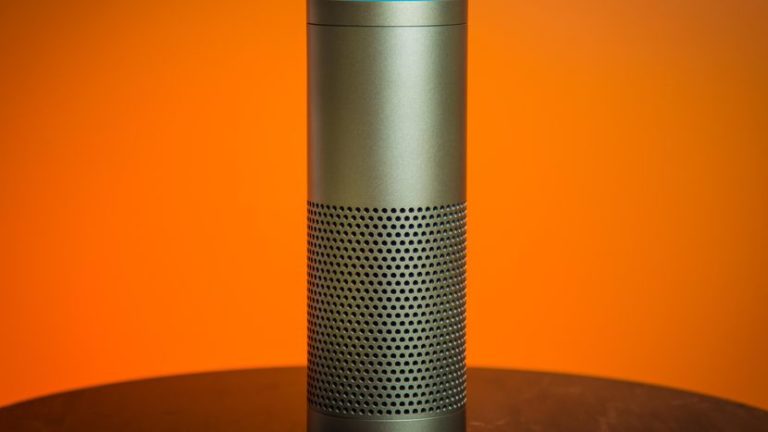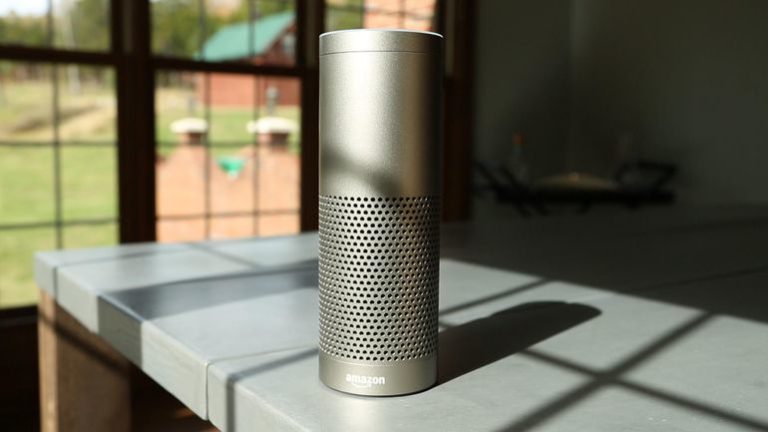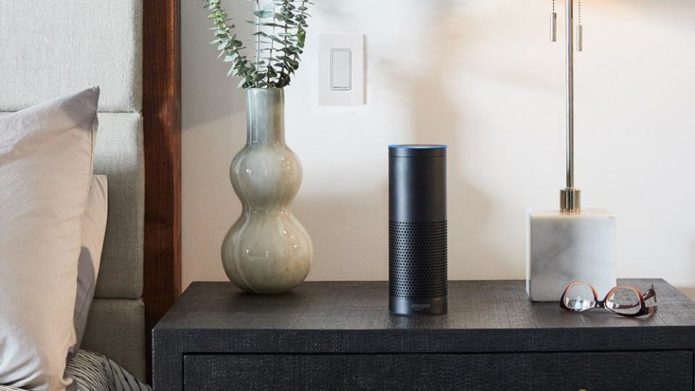The Good: The Echo Plus keeps the original Echo’s design (and its beloved volume ring) while adding in an aux-out jack, a Zigbee radio to control smart home devices, and an incremental boost in sound quality. It costs $30 less than the original Echo.
The Bad: The Plus also costs $50 more than the new Echo, which has everything the Plus has except for Zigbee. The Alexa app isn’t the fully capable smart home control center that the Echo Plus needs it to be, at least not yet.
The Bottom Line: Hold off on the Echo Plus until Amazon improves the Alexa app’s smart home controls.
If Alexa taught us anything, it’s the importance of good software. In Alexa’s case, it’s what made the original Amazon Echo ($129.95 at B&H Photo-Video) smart speaker so compelling. On its own, the Echo itself was just your average Bluetooth speaker — it was Alexa, Amazon’s cloud-connected, voice-activated AI assistant, that made the Echo a game-changer.

That brings us to the new Echo Plus. At $150 or £140, it looks just like the original Echo, but the “plus” part is that it adds in a radio for Zigbee, a wireless standard used by certain smart homegadgets, including Philips Hue smart bulbs, SmartThings plugs, and connected locks from Kwikset and Yale. Thanks to that Zigbee radio, the Echo Plus can talk directly to those gadgets and tell them what to do. You don’t need to plug an extra bridge or hub into your router to translate the Zigbee signals, because the Echo Plus is already fluent. It is the hub.
That, coupled with an incremental uptick in sound quality, makes the Echo Plus a good piece of hardware. The software, however, leaves a lot to be desired with clunky, underdeveloped smart home controls in the Alexa app that don’t do as much as they really should. The Echo Plus has other strengths, like an aux-out jack and a new ability to launch multifaceted “routines” with a single voice command — but they’re the same strengths that you’ll get with the new, second-gen Echo, which costs $50 or £50 less.
With the right app updates the Echo Plus could improve over time, and that’s probably what will happen. Until it does, though, I wouldn’t build a smart home around it.

Looks the same, sounds the same
![]()
The Echo Plus comes in your choice of three colors: black, white or a new silver option. Get it in black or white, and you’ll have a very hard time distinguishing it from the original.
The way to tell is in the back — the Echo Plus added in an aux-out jack, just like the second-gen Echo did. That’ll let you connect to external speakers using a 3.5mm cable (you can also connect wirelessly via Bluetooth). That’s a nice touch, but if you’re just looking for an Alexa device to connect with your high-end speaker setup, you’re better off just getting an Echo Dot and saving $100 or £90.
One other note: With the old design making an encore, the Echo Plus is now the only Alexa device currently on sale that offers a volume ring up top. The second-gen Echo ditched that volume ring in favor of the Echo Dot’s volume buttons to help get the cost down. I prefer the ring — it feels classier, and it’s easier to use in a dark room.
Speaking of sound quality, the Echo Plus does indeed sound a little bit better than the original Echo, at least to my ear. Both are almost equally as powerful, but I noticed better balance between highs and lows and slightly less distortion at high volumes with the Echo Plus. It’s a very subtle difference, and not one that you’re likely to notice unless, like me, you spend a good chunk of your day listening for it.
That puts the Echo Plus’ sound quality much closer to the Echo than to competitors that put more of an emphasis on pristine audio. Like the Echo, it’s perfectly capable of filling a room with good-sounding music, but if you’re hoping for a high-fidelity audio experience, you might come away disappointed.
A more noticeable uptick in sound quality would have gone a long way towards helping the Plus live up to its name, but the addition of an aux-out jack renders that point largely moot — audiophiles probably already have a setup they’re happy with, and in most cases, the Echo Plus can pipe music through it.
Zigbee smarts
![]()
The addition of a Zigbee radio means that the Echo Plus can connect directly with Zigbee gadgets, of which there are many. The most notable name in that mix is Philips Hue — with the Echo Plus, you can connect with any of the numerous Hue-branded lamps, light bulbs and light strips available and control them right from the Alexa app, no Hue Bridge necessary. That’s a tempting way to try out a single bulb before committing to an entire Philips Hue starter kit.
To that end, Amazon is currently offering a free Hue White LED with every Echo Plus, a $15 value. Nice touch.
Still, there’s a glaring problem with that integration with Hue, and that’s that the Alexa app can’t change the color of color-changing bulbs. Alexa can via voice command, but the app itself only lets you turn lights on and off or adjust their brightness. That obviously isn’t ideal — voice commands are great for quick changes, but sometimes, you’re going to want to use an app’s color selector to dial in on a specific shade.
You could do so easily using the Philips Hue app — but the app can’t connect with the bulbs unless you’ve got the Hue Bridge plugged into your router. Kind of undercuts the whole point of having an Echo Plus, doesn’t it?
That limitation extends to other Zigbee bulbs with multiple color settings, too. For instance, I was able to pair the Echo Plus with a Tradfri smart bulb from Ikea that offers different color temperature settings ranging from warm white to cool daylight. I could adjust the tint of the light using voice commands, but not using the Alexa app. Alexa, add color control to your to-do list.
Another shortcoming — the Echo Plus can’t really do anything with things like motion detectors, open/closed sensors for doors and windows, leak detectors, sirens and other common Zigbee devices. You can pair them with the Echo Plus and see them in the app, but you can’t use the app to automate them alongside your lights, locks, thermostats and other Alexa-friendly devices. For now, they’re just dead weight, which undercuts the Echo Plus’ smart hub appeal even further.
For all I know, support for devices like these could be an app update away, but Amazon wouldn’t speculate on its roadmap when I asked, telling me, “Alexa is always getting smarter and we aim to make updates based on customer feedback.”

One last note: Zigbee opens up a lot of new possibilities, but it’s just one standard. Most smart home hubs are compatible with multiple standards, including both Zigbee and Z-Wave. Amazon could have positioned the Echo Plus a little better by following suit, or even by going one step further and partnering with a proprietary brand such as Lutron or Insteon to offer direct control of those devices, too. Instead, you just get Zigbee. That’s good, but not great.
New Echo, new software
You know how you get excited when a new version of your phone’s operating system arrives, complete with all sorts of new features and gimmicks to try out? Take that feeling and stretch it out over several months, with the new features arriving every week or two. That’s what it’s like owning an Echo device. It’s an ever-evolving, voice-activated operating system.
The latest addition to Alexa’s bag of tricks is a feature called routines. The idea is simple — you pick your own custom Alexa command, then you pick what you want to have happen whenever you say it. A single routine can trigger multiple things at once — for instance, saying, “Alexa, goodnight,” could turn your lights off, lock your doors and fire up a bedroom space heater.
There’s room for creativity here. For instance, you could say, “Alexa, wake up the kid,” to trigger a routine that would turn their bedroom lights on and start playing the morning’s flash briefing from the Echo Dot on their nightstand. Nothing like a little NPR to nudge Junior out of bed.
![]()
The truly sadistic among us might prefer to wake a sleepy teenager by blasting out, say, Chumbawumba, or perhaps a rousing rendition of “Who Let the Dogs Out?” Unfortunately (or fortunately, in Junior’s case), triggering songs and playlists isn’t an option with routines. I’d love to see Amazon change that and start allowing users to bring music playback — still one of Alexa’s core features — into the fold. Heck, it could even be an exclusive feature for Amazon Music Unlimited subscribers. That’d be enough to get me to switch over from Spotify (and if nothing else, it could make for some entertaining new Alexa commercials).
There are other limitations with routines. For instance, that wake-up routine can turn the lights on, but you can’t set it to gradually fade them on like you can with a good, dedicated smart lighting app (Philips Hue, Lifx, Lutron and others can all handle prescheduled fades). And while you can trigger any scenes that you’ve imported in from apps like those, you can’t trigger groups of devices. Instead, you have to trigger each device individually within the routine.
Another big limitation: routines don’t currently support smart thermostats such as the Nest or the Ecobee4. Chalk another one up for Alexa’s to-do list.
Still, the pros outweigh the cons. The ability to craft your own custom Alexa commands is long overdue; the fact that those commands can trigger multiple things at once only sweetens the deal. And, like the rest of Alexa’s features, it’s a feature that should improve over time.
Routines aren’t specific to the Echo Plus — you can program them with any Echo device, even the old ones. The same goes for the fact that you can now add each of your Echo devices in with a default group of lights, then control those lights just by saying “turn the lights on.” Both are nice steps forward for Alexa, but neither is a reason to pick the Echo Plus over any other Echo gadget.
As for the app itself, it got a minor design overhaul just in time for the Echo Plus, with a new layout for your smart home gadgets and new in-app controls for turning everything on and off. Tap a little question mark icon, and you’ll also find helpful and specific pairing instructions for all of the compatible Zigbee brands.
The app is a bit bland-looking, and it isn’t as neatly organized as other smart home control apps. It lists your devices in alphabetical order, and you can’t sort them by room or by date added. It isn’t terrible by any stretch, but it’s too basic to call itself a comprehensive smart home control app, and too basic to set itself apart from better-developed competitors.

Plus or minus?
The Echo Plus has plenty of potential. Alexa has already proven to be a capable quarterback for the connected living space — packing her into a dedicated smart home hub makes plenty of sense.
Still, that hub has to be good. And while it’s just as good a smart speaker as the original Echo, if not better, the Echo Plus is actually a pretty mediocre hub. It isn’t as fully featured as the competition. It only works with Zigbee. It doesn’t do anything with sensors and sirens. The app is poorly organized.
I almost wonder if Amazon would have been better off foregoing the full-sized approach and, instead, making the Echo Plus more like the Echo Dot. After all, the Zigbee radio is the only real reason to buy the Plus over another Echo device — by packing it into a full-sized speaker at $150 or £140, Amazon is forcing Zigbee enthusiasts to pay for more than they may actually need.
All of that is enough for me to tell you to wait on the Echo Plus. There’s plenty of potential, yes, but it just isn’t there yet.
(cnet.com, https://goo.gl/w5ynCv)


